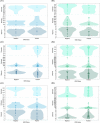White-nose syndrome restructures bat skin microbiomes
- PMID: 37888992
- PMCID: PMC10714735
- DOI: 10.1128/spectrum.02715-23
White-nose syndrome restructures bat skin microbiomes
Abstract
Inherent complexities in the composition of microbiomes can often preclude investigations of microbe-associated diseases. Instead of single organisms being associated with disease, community characteristics may be more relevant. Longitudinal microbiome studies of the same individual bats as pathogens arrive and infect a population are the ideal experiment but remain logistically challenging; therefore, investigations like our approach that are able to correlate invasive pathogens to alterations within a microbiome may be the next best alternative. The results of this study potentially suggest that microbiome-host interactions may determine the likelihood of infection. However, the contrasting relationship between Pd and the bacterial microbiomes of Myotis lucifugus and Perimyotis subflavus indicate that we are just beginning to understand how the bat microbiome interacts with a fungal invader such as Pd.
Keywords: Eptesicus fuscus; Myotis lucifugus; Perimyotis subflavus; Pseudogymnoascus destructans; bat populations; disease ecology; microbiome; white-nose syndrome.
Conflict of interest statement
The authors declare no conflict of interest.
Figures





Similar articles
-
Cooling of bat hibernacula to mitigate white-nose syndrome.Conserv Biol. 2022 Apr;36(2):e13803. doi: 10.1111/cobi.13803. Epub 2021 Oct 26. Conserv Biol. 2022. PMID: 34224186
-
Efficacy of Visual Surveys for White-Nose Syndrome at Bat Hibernacula.PLoS One. 2015 Jul 21;10(7):e0133390. doi: 10.1371/journal.pone.0133390. eCollection 2015. PLoS One. 2015. PMID: 26197236 Free PMC article.
-
Effects of white-nose syndrome on regional population patterns of 3 hibernating bat species.Conserv Biol. 2016 Oct;30(5):1048-59. doi: 10.1111/cobi.12690. Epub 2016 Jul 18. Conserv Biol. 2016. PMID: 26872411
-
COULD WHITE-NOSE SYNDROME MANIFEST DIFFERENTLY IN MYOTIS LUCIFUGUS IN WESTERN VERSUS EASTERN REGIONS OF NORTH AMERICA? A REVIEW OF FACTORS.J Wildl Dis. 2023 Jul 1;59(3):381-397. doi: 10.7589/JWD-D-22-00050. J Wildl Dis. 2023. PMID: 37270186 Review.
-
Ecology and impacts of white-nose syndrome on bats.Nat Rev Microbiol. 2021 Mar;19(3):196-210. doi: 10.1038/s41579-020-00493-5. Epub 2021 Jan 18. Nat Rev Microbiol. 2021. PMID: 33462478 Review.
Cited by
-
Isolation of Antagonistic Bacterial Strains and Their Antimicrobial Volatile Organic Compounds Against Pseudogymnoascus destructans in Rhinolophus ferrumequinum Wing Membranes.Ecol Evol. 2025 Jun 27;15(7):e71628. doi: 10.1002/ece3.71628. eCollection 2025 Jul. Ecol Evol. 2025. PMID: 40584655 Free PMC article.
-
DNA metabarcoding analyses reveal fine-scale microbiome structures on Western Canadian bat wings.Microbiol Spectr. 2024 Oct 22;12(12):e0037624. doi: 10.1128/spectrum.00376-24. Online ahead of print. Microbiol Spectr. 2024. PMID: 39436130 Free PMC article.
-
Variation and assembly mechanisms of Rhinolophus ferrumequinum skin and cave environmental fungal communities during hibernation periods.Microbiol Spectr. 2025 Mar 4;13(3):e0223324. doi: 10.1128/spectrum.02233-24. Epub 2025 Jan 23. Microbiol Spectr. 2025. PMID: 39846756 Free PMC article.
-
Microbiota diversity and anti-Pseudogymnoascus destructans bacteria isolated from Myotis pilosus skin during late hibernation.Appl Environ Microbiol. 2024 Aug 21;90(8):e0069324. doi: 10.1128/aem.00693-24. Epub 2024 Jul 26. Appl Environ Microbiol. 2024. PMID: 39058040 Free PMC article.
-
Skin Microbiota Variation Among Bat Species in China and Their Potential Defense Against Pathogens.Front Microbiol. 2022 Mar 31;13:808788. doi: 10.3389/fmicb.2022.808788. eCollection 2022. Front Microbiol. 2022. PMID: 35432245 Free PMC article.
References
-
- Kong HH, Oh J, Deming C, Conlan S, Grice EA, Beatson MA, Nomicos E, Polley EC, Komarow HD, Program NCS, Murray PR, Turner ML, Segre JA. 2012. Temporal shifts in the skin microbiome associated with disease flares and treatment in children with atopic dermatitis. Genome Res 22:850–859. doi: 10.1101/gr.131029.111 - DOI - PMC - PubMed

